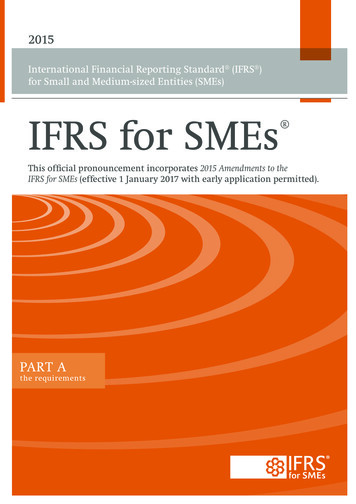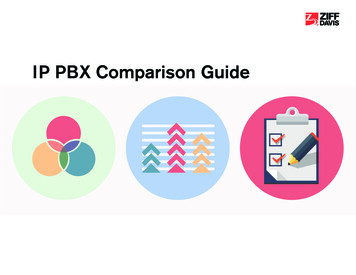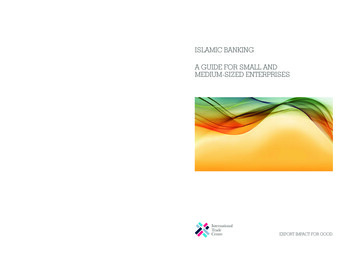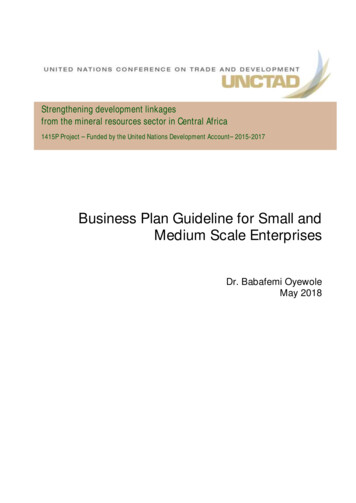
Transcription
2015International Financial Reporting Standard (IFRS )for Small and Medium-sized Entities (SMEs)IFRS for SMEs This official pronouncement incorporates 2015 Amendments to theIFRS for SMEs (effective 1 January 2017 with early application permitted).PART Athe requirements
International Financial ReportingStandard for Small and Medium-sizedEntities (IFRS for SMEs)
The International Financial Reporting Standard for Small and Medium-sized Entities (IFRS for SMEs) is issued by theInternational Accounting Standards Board (IASB).Disclaimer: the IASB, the IFRS Foundation, the authors and the publishers do not accept responsibilityfor any loss caused by acting or refraining from acting in reliance on the material in this publication,whether such loss is caused by negligence or otherwise.International Financial Reporting Standards (including International Accounting Standards and SIC andIFRIC Interpretations), Exposure Drafts and other IASB and/or IFRS Foundation publications arecopyright of the IFRS Foundation.Copyright 2015 IFRS Foundation ISBN for this part: 978-1-911040-08-8ISBN for complete publication (two parts): 978-1-911040-07-1All rights reserved. No part of this publication may be translated, reprinted, reproduced or used inany form either in whole or in part or by any electronic, mechanical or other means, now known orhereafter invented, including photocopying and recording, or in any information storage and retrievalsystem, without prior permission in writing from the IFRS Foundation.The approved text of International Financial Reporting Standards and other IASB publications is thatpublished by the IASB in the English language. Copies may be obtained from the IFRS Foundation.Please address publications and copyright matters to:IFRS Foundation Publications Department30 Cannon Street, London EC4M 6XH, United KingdomTel: 44 (0)20 7332 2730 Fax: 44 (0)20 7332 2749Email: publications@ifrs.org Web: www.ifrs.orgThe IFRS Foundation logo/the IASB logo/the IFRS for SMEs logo/‘Hexagon Device’, ‘IFRS Foundation’,‘IFRS Taxonomy’, ‘eIFRS’, ‘IASB’, ‘IFRS for SMEs’, ‘IAS’, ‘IASs’, ‘IFRIC’, ‘IFRS’, ‘IFRSs’, ‘SIC’, ‘InternationalAccounting Standards’ and ‘International Financial Reporting Standards’ are Trade Marks of the IFRSFoundation.Further details of the Trade Marks, including details of countries where the Trade Marks are registeredor applied for, are available from the IFRS Foundation on request.The IFRS Foundation is a not-for-profit corporation under the General Corporation Law of the State ofDelaware, USA and operates in England and Wales as an overseas company (Company number:FC023235) with its principal office as above.
IFRSFORSMES—2015CONTENTSfrom pageINTERNATIONAL FINANCIAL REPORTING STANDARDFOR SMALL AND MEDIUM-SIZED ENTITIES (IFRS FOR SMEs)PREFACE6Section1 SMALL AND MEDIUM-SIZED ENTITIES102 CONCEPTS AND PERVASIVE PRINCIPLES123 FINANCIAL STATEMENT PRESENTATION224 STATEMENT OF FINANCIAL POSITION275 STATEMENT OF COMPREHENSIVE INCOME AND INCOME STATEMENT316 STATEMENT OF CHANGES IN EQUITY AND STATEMENT OF INCOME ANDRETAINED EARNINGS347 STATEMENT OF CASH FLOWS368 NOTES TO THE FINANCIAL STATEMENTS419 CONSOLIDATED AND SEPARATE FINANCIAL STATEMENTS4310 ACCOUNTING POLICIES, ESTIMATES AND ERRORS5011 BASIC FINANCIAL INSTRUMENTS5512 OTHER FINANCIAL INSTRUMENT ISSUES7113 INVENTORIES7914 INVESTMENTS IN ASSOCIATES8415 INVESTMENTS IN JOINT VENTURES8816 INVESTMENT PROPERTY9217 PROPERTY, PLANT AND EQUIPMENT9518 INTANGIBLE ASSETS OTHER THAN GOODWILL10219 BUSINESS COMBINATIONS AND GOODWILL10720 LEASES11321 PROVISIONS AND CONTINGENCIES121Appendix—Guidance on recognising and measuring provisions12522 LIABILITIES AND EQUITY130Appendix—Example of the issuer’s accounting for convertible debt13723 REVENUE140Appendix—Examples of revenue recognition under the principles inSection 2314724 GOVERNMENT GRANTS15325 BORROWING COSTS15526 SHARE-BASED PAYMENT15627 IMPAIRMENT OF ASSETS16328 EMPLOYEE BENEFITS17129 INCOME TAX1823姝 IFRS Foundation
IFRSFORSMES—201530 FOREIGN CURRENCY TRANSLATION19231 HYPERINFLATION19832 EVENTS AFTER THE END OF THE REPORTING PERIOD20133 RELATED PARTY DISCLOSURES20434 SPECIALISED ACTIVITIES20835 TRANSITION TO THE IFRS FOR SMEs213APPENDIX A: EFFECTIVE DATE AND TRANSITION219APPENDIX B: GLOSSARY OF TERMS220DERIVATION TABLE241APPROVAL BY THE BOARD OF THE IFRS FOR SMEs ISSUED IN JULY 2009243APPROVAL BY THE BOARD OF THE 2015 AMENDMENTS TO THE IFRS FORSMEs ISSUED IN MAY 2015244FOR THE ACCOMPANYING DOCUMENTS LISTED BELOW, SEE PART B OF THISEDITIONBASIS FOR CONCLUSIONSILLUSTRATIVE FINANCIAL STATEMENTS姝 IFRS Foundation4
IFRSFORSMES—2015The International Financial Reporting Standard for Small and Medium-sized Entities (IFRS for SMEs)is set out in Sections 1–35 and Appendices A–B. Terms defined in the Glossary are inbold type the first time they appear in each section, as appropriate. The IFRS for SMEs isaccompanied by a Preface, a Derivation Table, a Basis for Conclusions andImplementation Guidance consisting of illustrative financial statements and a table thatcollates the presentation and disclosure requirements in the IFRS for SMEs.5姝 IFRS Foundation
IFRSFORSMES—2015Preface to the IFRS for SMEsThe IASBP1The International Accounting Standards Board (IASB) was established in 2001 aspart of the International Accounting Standards Committee (IASC) Foundation.In 2010 the IASC Foundation was renamed the IFRS Foundation.P2The governance of the IFRS Foundation rests with 22 Trustees. The Trustees’responsibilities include appointing the members of the IASB and associatedcouncils and committees, as well as securing financing for the organisation.P3The objectives of the IASB are:P4(a)to develop, in the public interest, a single set of high quality,understandable, enforceable and globally accepted financial reportingStandards based on clearly articulated principles. These Standardsshould require high quality, transparent and comparable information infinancial statements and other financial reporting to help investors,other participants in the various capital markets of the world and otherusers of financial information make economic decisions.(b)to promote the use and rigorous application of those Standards.(c)in fulfilling the objectives associated with (a) and (b), to take account of,as appropriate, the needs of a range of sizes and types of entities indiverse economic settings.(d)to promote and facilitate the adoption of its Standards.Approval of Standards and related documents, such as, Exposure Drafts andother discussion documents, is the responsibility of the IASB.Full International Financial Reporting Standards (full IFRS)P5The IASB achieves its objectives primarily by developing and publishingStandards and promoting their use in general purpose financial statements andother financial reporting. Other financial reporting comprises informationprovided outside financial statements that assists in the interpretation of acomplete set of financial statements or improves users’ ability to make efficienteconomic decisions. The term ‘financial reporting’ encompasses generalpurpose financial statements plus other financial reporting.P6Full IFRS sets out recognition, measurement, presentation and disclosurerequirements dealing with transactions and events that are important ingeneral purpose financial statements. They may also set out such requirementsfor transactions, events and conditions that arise mainly in specific industries.Full IFRS is based on the Conceptual Framework, which addresses the conceptsunderlying the information presented in general purpose financial statements.The objective of the Conceptual Framework is to facilitate the consistent and logicalformulation of full IFRS. It also provides a basis for the use of judgement inresolving accounting issues.姝 IFRS Foundation6
IFRSFORSMES—2015General purpose financial statementsP7The IASB’s Standards are designed to apply to general purpose financialstatements and other financial reporting of all profit-oriented entities. Generalpurpose financial statements are directed towards the common informationneeds of a wide range of users, for example, shareholders, creditors, employeesand the public at large. The objective of financial statements is to provideinformation about the financial position, performance and cash flows of anentity that is useful to those users in making economic decisions.P8General purpose financial statements are those directed to general financialinformation needs of a wide range of users who are not in a position to demandreports tailored to meet their particular information needs. General purposefinancial statements include those that are presented separately or withinanother public document such as an annual report or a prospectus.The IFRS for SMEsP9The IASB develops and issues a separate Standard intended to apply to thegeneral purpose financial statements of, and other financial reporting by,entities that in many countries are referred to by a variety of terms, includingsmall and medium-sized entities (SMEs), private entities and non-publiclyaccountable entities. That Standard is the International Financial ReportingStandard for Small and Medium-sized Entities (IFRS for SMEs). The IFRS for SMEs is basedon full IFRS with modifications to reflect the needs of users of SMEs’ financialstatements and cost-benefit considerations.P10The term small and medium-sized entities as used by the IASB is defined andexplained in Section 1 Small and Medium-sized Entities. Many jurisdictions aroundthe world have developed their own definitions of SMEs for a broad range ofpurposes including prescribing financial reporting obligations. Often thosenational or regional definitions include quantified criteria based on revenue,assets, employees or other factors. Frequently, the term SMEs is used to mean orto include very small entities without regard to whether they publish generalpurpose financial statements for external users.P11SMEs often produce financial statements only for the use of owner-managers oronly for the use of tax authorities or other governmental authorities. Financialstatements produced solely for those purposes are not necessarily generalpurpose financial statements.P12Tax laws are specific to each jurisdiction, and the objectives of general purposefinancial reports differ from the objectives of reporting taxable profit. Thus,financial statements prepared in conformity with the IFRS for SMEs are unlikelyto comply fully with all of the measurements required by a jurisdiction’s taxlaws and regulations. A jurisdiction may be able to lessen the ‘dual reportingburden’ on SMEs by structuring tax reports as reconciliations from the profit orloss determined in accordance with the IFRS for SMEs and by other means.7姝 IFRS Foundation
IFRSFORSMES—2015Authority of the IFRS for SMEsP13Decisions on which entities are required or permitted to use the IASB’sStandards rest with legislative and regulatory authorities and standard-setters inindividual jurisdictions. This is true for full IFRS and for the IFRS for SMEs.However, a clear definition of the class of entity for which the IFRS for SMEs isintended—as set out in Section 1 of the Standard—is essential so that:(a)the IASB can decide on the accounting and disclosure requirements thatare appropriate for that class of entity; and(b)the legislative and regulatory authorities, standard-setters and reportingentities and their auditors will be informed of the intended scope ofapplicability of the IFRS for SMEs.A clear definition is also essential so that entities that are not small ormedium-sized entities, and therefore are not eligible to use the IFRS for SMEs, donot assert that they are in compliance with it (see paragraph 1.5).Organisation of the IFRS for SMEsP14The IFRS for SMEs is organised by topic, with each topic presented in a separatenumbered section. Cross-references to paragraphs are identified by sectionnumber followed by paragraph number. Paragraph numbers are in the formxx.yy, where xx is the section number and yy is the sequential paragraphnumber within that section. In examples that include monetary amounts, themeasuring unit is Currency Units (abbreviated as CU).P15All of the paragraphs in the IFRS for SMEs have equal authority. Some sectionsinclude appendices of implementation guidance that are not part of theStandard but, instead, are guidance for applying it.Maintenance of the IFRS for SMEsP16The IASB expects to propose amendments to the IFRS for SMEs by publishing anomnibus Exposure Draft periodically, but not more frequently thanapproximately once every three years. In developing those Exposure Drafts, itexpects to consider new and amended full IFRS Standards as well as specificissues that have been brought to its attention regarding application of the IFRSfor SMEs. On occasion, the IASB may identify an urgent matter for whichamendment of the IFRS for SMEs may need to be considered outside the periodicreview process. However, such occasions are expected to be rare.P17Until the IFRS for SMEs is amended, any changes that the IASB may make orpropose with respect to full IFRS do not apply to the IFRS for SMEs. The IFRS forSMEs is a stand-alone document. SMEs shall not anticipate or apply changesmade in full IFRS before those changes are incorporated into the IFRS for SMEsunless, in the absence of specific guidance in the IFRS for SMEs, an SME chooses toapply guidance in full IFRS and those principles do not conflict withrequirements in the hierarchy in paragraphs 10.4–10.5.姝 IFRS Foundation8
IFRSP18FORSMES—2015The IASB expects that there will be a period of at least one year between whenamendments to the IFRS for SMEs are issued and the effective date of thoseamendments.9姝 IFRS Foundation
IFRSFORSMES—2015International Financial Reporting Standard (IFRS) for Smalland Medium-sized EntitiesSection 1Small and Medium-sized EntitiesIntended scope of this Standard1.1The IFRS for SMEs is intended for use by small and medium-sized entities(SMEs). This section describes the characteristics of SMEs.Description of small and medium-sized entities1.2Small and medium-sized entities are entities that:(a)do not have public accountability; and(b)publish general purpose financial statements for external users.Examples of external users include owners who are not involved in managingthe business, existing and potential creditors, and credit rating agencies.1.3An entity has public accountability if:(a)its debt or equity instruments are traded in a public market or it is in theprocess of issuing such instruments for trading in a public market (adomestic or foreign stock exchange or an over-the-counter market,including local and regional markets); or(b)it holds assets in a fiduciary capacity for a broad group of outsiders asone of its primary businesses (most banks, credit unions, insurancecompanies, securities brokers/dealers, mutual funds and investmentbanks would meet this second criterion).1.4Some entities may also hold assets in a fiduciary capacity for a broad group ofoutsiders because they hold and manage financial resources entrusted to themby clients, customers or members not involved in the management of the entity.However, if they do so for reasons incidental to a primary business (as, forexample, may be the case for travel or real estate agents, schools, charitableorganisations, co-operative enterprises requiring a nominal membership depositand sellers that receive payment in advance of delivery of the goods or servicessuch as utility companies), that does not make them publicly accountable.1.5If a publicly accountable entity uses this Standard, its financial statements shallnot be described as conforming to the IFRS for SMEs—even if law or regulation inits jurisdiction permits or requires this Standard to be used by publiclyaccountable entities.1.6A subsidiary whose parent uses full IFRS, or that is part of a consolidatedgroup that uses full IFRS, is not prohibited from using this Standard in its ownfinancial statements if that subsidiary by itself does not have publicaccountability. If its financial statements are described as conforming to theIFRS for SMEs, it must comply with all of the provisions of this Standard.姝 IFRS Foundation10
IFRS1.7FORSMES—2015A parent entity (including the ultimate parent or any intermediate parent)assesses its eligibility to use this Standard in its separate financial statementson the basis of its own status without considering whether other group entitieshave, or the group as a whole has, public accountability. If a parent entity byitself does not have public accountability, it may present its separate financialstatements in accordance with this Standard (see Section 9 Consolidated andSeparate Financial Statements), even if it presents its consolidated financialstatements in accordance with full IFRS or another set of generally acceptedaccounting principles (GAAP), such as its national accounting standards. Anyfinancial statements prepared in accordance with this Standard shall be clearlydistinguished from financial statements prepared in accordance with otherrequirements.11姝 IFRS Foundation
IFRSFORSMES—2015Section 2Concepts and Pervasive PrinciplesScope of this section2.1This section describes the objective of financial statements of small andmedium-sized entities (SMEs) and the qualities that make the information inthe financial statements of SMEs useful. It also sets out the concepts and basicprinciples underlying the financial statements of SMEs.Objective of financial statements of small and medium-sizedentities2.2The objective of financial statements of a small or medium-sized entity is toprovide information about the financial position, performance and cashflows of the entity that is useful for economic decision-making by a broad rangeof users of the financial statements who are not in a position to demand reportstailored to meet their particular information needs.2.3Financial statements also show the results of the stewardship ofmanagement—the accountability of management for the resources entrusted toit.Qualitative characteristics of information in financial statementsUnderstandability2.4The information provided in financial statements should be presented in a waythat makes it comprehensible by users who have a reasonable knowledge ofbusiness and economic activities and accounting and a willingness to study theinformation with reasonable diligence.However, the need forunderstandability does not allow relevant information to be omitted on thegrounds that it may be too difficult for some users to understand.Relevance2.5The information provided in financial statements must be relevant to thedecision-making needs of users. Information has the quality of relevance whenit is capable of influencing the economic decisions of users by helping themevaluate past, present or future events or confirming, or correcting, their pastevaluations.Materiality2.6Information is material—and therefore has relevance—if its omission ormisstatement could influence the economic decisions of users made on the basisof the financial statements. Materiality depends on the size and nature of theomission or misstatement judged in the surrounding circumstances. However,it is inappropriate to make, or leave uncorrected, immaterial departures fromthe IFRS for SMEs to achieve a particular presentation of an entity’s financialposition, financial performance or cash flows.姝 IFRS Foundation12
IFRSFORSMES—2015Reliability2.7The information provided in financial statements must be reliable. Informationis reliable when it is free from material error and bias and represents faithfullythat which it either purports to represent or could reasonably be expected torepresent. Financial statements are not free from bias (ie not neutral) if, by theselection or presentation of information, they are intended to influence themaking of a decision or judgement in order to achieve a predetermined result oroutcome.Substance over form2.8Transactions and other events and conditions should be accounted for andpresented in accordance with their substance and not merely their legal form.This enhances the reliability of financial statements.Prudence2.9The uncertainties that inevitably surround many events and circumstances areacknowledged by the disclosure of their nature and extent and by the exercise ofprudence in the preparation of the financial statements. Prudence is theinclusion of a degree of caution in the exercise of the judgements needed inmaking the estimates required under conditions of uncertainty, such thatassets or income are not overstated and liabilities or expenses are notunderstated. However, the exercise of prudence does not allow the deliberateunderstatement of assets or income or the deliberate overstatement of liabilitiesor expenses. In short, prudence does not permit bias.Completeness2.10To be reliable, the information in financial statements must be complete withinthe bounds of materiality and cost. An omission can cause information to befalse or misleading and thus unreliable and deficient in terms of its relevance.Comparability2.11Users must be able to compare the financial statements of an entity throughtime to identify trends in its financial position and performance. Users mustalso be able to compare the financial statements of different entities to evaluatetheir relative financial position, performance and cash flows. Hence, themeasurement and display of the financial effects of like transactions and otherevents and conditions must be carried out in a consistent way throughout anentity and over time for that entity and in a consistent way across entities. Inaddition, users must be informed of the accounting policies employed in thepreparation of the financial statements and of any changes in those policies andthe effects of such changes.Timeliness2.12To be relevant, financial information must be able to influence the economicdecisions of users. Timeliness involves providing the information within thedecision time frame. If there is undue delay in the reporting of information itmay lose its relevance. Management may need to balance the relative merits oftimely reporting and the provision of reliable information. In achieving a13姝 IFRS Foundation
IFRSFORSMES—2015balance between relevance and reliability, the overriding consideration is howbest to satisfy the needs of users in making economic decisions.Balance between benefit and cost2.13The benefits derived from information should exceed the cost of providing it.The evaluation of benefits and costs is substantially a judgemental process.Furthermore, the costs are not necessarily borne by those who enjoy thebenefits, and often the benefits of the information are enjoyed by a broad rangeof external users.2.14Financial reporting information helps capital providers make better decisions,which results in more efficient functioning of capital markets and a lower costof capital for the economy as a whole. Individual entities also enjoy benefits,including improved access to capital markets, favourable effect on publicrelations and perhaps lower costs of capital. The benefits may also includebetter management decisions because financial information used internally isoften based at least partly on information prepared for general purpose financialreporting purposes.Undue cost or effort2.14AAn undue cost or effort exemption is specified for some requirements in thisStandard. This exemption shall not be used for other requirements in thisStandard.2.14BConsidering whether obtaining or determining the information necessary tocomply with a requirement would involve undue cost or effort depends on theentity’s specific circumstances and on management’s judgement of the costs andbenefits from applying that requirement.This judgement requiresconsideration of how the economic decisions of those that are expected to usethe financial statements could be affected by not having that information.Applying a requirement would involve undue cost or effort by an SME if theincremental cost (for example, valuers’ fees) or additional effort (for example,endeavours by employees) substantially exceed the benefits that those that areexpected to use the SME’s financial statements would receive from having theinformation. An assessment of undue cost or effort by an SME in accordancewith this Standard would usually constitute a lower hurdle than an assessmentof undue cost or effort by a publicly accountable entity because SMEs are notaccountable to public stakeholders.2.14CAssessing whether a requirement would involve undue cost or effort on initialrecognition in the financial statements, for example at the date of thetransaction, should be based on information about the costs and benefits of therequirement at the time of initial recognition. If the undue cost or effortexemption also applies subsequent to initial recognition, for example to asubsequent measurement of an item, a new assessment of undue cost or effortshould be made at that subsequent date, based on information available at thatdate.2.14DExcept for the undue cost or effort exemption in paragraph 19.15, which iscovered by the disclosure requirements in paragraph 19.25, whenever an undue姝 IFRS Foundation14
IFRSFORSMES—2015cost or effort exemption is used by an entity, the entity shall disclose that factand the reasons why applying the requirement would involve undue cost oreffort.Financial position2.152.16The financial position of an entity is the relationship of its assets, liabilities andequity as of a specific date as presented in the statement of financialposition. These are defined as follows:(a)an asset is a resource controlled by the entity as a result of past eventsand from which future economic benefits are expected to flow to theentity;(b)a liability is a present obligation of the entity arising from past events,the settlement of which is expected to result in an outflow from theentity of resources embodying economic benefits; and(c)equity is the residual interest in the assets of the entity after deductingall its liabilities.Some items that meet the definition of an asset or a liability may not berecognised as assets or liabilities in the statement of financial position becausethey do not satisfy the criteria for recognition in paragraphs 2.27–2.32. Inparticular, the expectation that future economic benefits will flow to or from anentity must be sufficiently certain to meet the probability criterion before anasset or liability is recognised.Assets2.17The future economic benefit of an asset is its potential to contribute, directly orindirectly, to the flow of cash and cash equivalents to the entity. Those cashflows may come from using the asset or from disposing of it.2.18Many assets, for example property, plant and equipment, have a physicalform. However, physical form is not essential to the existence of an asset. Someassets are intangible.2.19In determining the existence of an asset, the right of ownership is not essential.Thus, for example, property held on a lease is an asset if the entity controls thebenefits that are expected to flow from the property.Liabilities2.20An essential characteristic of a liability is that the entity has a present obligationto act or perform in a particular way. The obligation may be either a legalobligation or a constructive obligation. A legal obligation is legallyenforceable as a consequence of a binding contract or statutory requirement. Aconstructive obligation is an obligation that derives from an entity’s actionswhen:(a)by an established pattern of past practice, published policies or asufficiently specific current statement, the entity has indicated to otherparties that it will accept certain responsibilities; and15姝 IFRS Foundation
IFRS(b)2.21FORSMES—2015as a result, the entity has created a valid expectation on the part of thoseother parties that it will discharge those responsibilities.The settlement of a present obligation usually involves the payment of cash, thetransfer of other assets, the provision of services, the replacement of thatobligation with another obligation or the conversion of the obligation to equity.An obligation may also be extinguished by other means, such as a creditorwaiving or forfeiting its rights.Equity2.22Equity is the residual of recognised assets minus recognised liabilities. It may besubclassified in the statement of financial position. For example, in a corporateentity, subclassifications may include funds contributed by shareholders,retained earnings and items of other comprehensive income recognised as aseparate component of equity. This Standard does not prescribe how, when or ifamounts can be transferred between components of equity.Performance2.232.24Performance is the relationship of the income and expenses of an entity duringa reporting period. This Standard permits entities to present performance in asingle financial statement (a statement of comprehensive income) or in twofinancial statements (an income statement and a statement of comprehensiveincome). Total comprehensive income and profit or loss are frequently usedas measures of performance or as the basis for other measures, such as return oninvestment or earnings per share. Income and expenses are defined as follows:(a)income is increases in economic benefits during the reporting period inthe form of inflows or enhancements of assets or decreases of liabilitiesthat result in increases in equity, other than those relating tocontributions from owners; and(b)expenses are decreases in economic benefits during the reporting periodin the form of outflows or depletions of assets or incurrences of liabilitiesthat result in decreases in equity, other than those relating todistributions to owners.The recognition of income and expenses results directly from the recognitionand measurement of assets and liabilities. Criteria for the recogni
Appendix—Examples of revenue recognition under the principles in Section 23 147 24 GOVERNMENT GRANTS 153 25 BORROWING COSTS 155 26 SHARE-BASED PAYMENT 156 27 IMPAIRMENT OF ASSETS 163 28 EMPLOYEE BENEFITS 171 29 INCOME TAX 182 IFRS FOR SMES—2015 3 IFRS Foundation. 30 FOREIGN CURRENCY TRANSLATION 192











